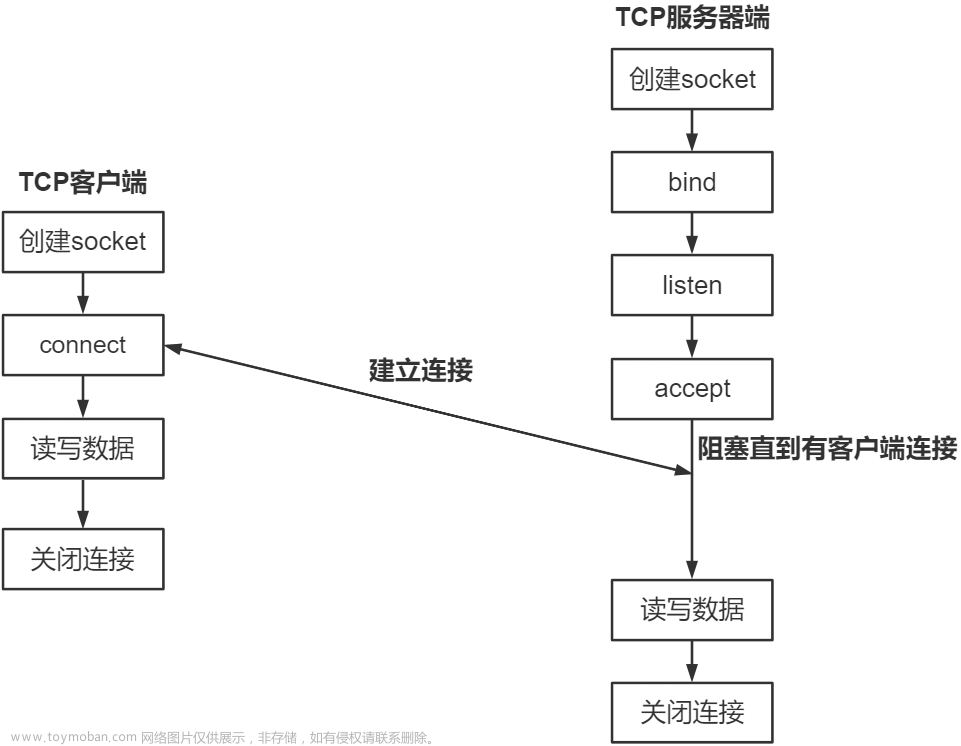- QTcpServer用于TCP/IP通信, 作为服务器端套接字使用。
- QTcpSocket用于TCP/IP通信,作为客户端套接字使用。
- QUdpSocket用于UDP通信,服务器,客户端均使用此套接字。
-
创建套接字
-
将套接字设置为监听模式
-
等待并接受客户端请求
可以通过QTcpServer提供的void newConnection()信号来检测是否有连接请求,如果有可以在对应的槽函数中调用nextPendingConnection函数获取到客户端的Socket信息(返回值为QTcpSocket*类型指针),通过此套接字与客户端之间进行通信。 -
接收或者向客户端发送数据 接收数据:使用read()或者readAll()函数
-
发送数据:使用write()函数
-
客户端通信流程:
-
1.创建套接字 ;
-
2.连接服务器 可以使用QTcpSocket类的connectToHost()函数来连接服务器。
-
3.向服务器发送或者接受数据 ;
通过Qt提供的QTcpServer类实现服务器端的socket通信:文章来源:https://www.toymoban.com/news/detail-446680.html
class TCPServer : public QMainWindow
{
Q_OBJECT
public:
explicit TCPServer(QWidget *parent = 0);
~TCPServer();
public slots:
void slotNewConnection();
void slotReadyRead();
private:
Ui::TCPServer *ui;
// 负责监听的套接字
QTcpServer* m_server;
// 负责通信的套接字
QTcpSocket* m_client;
};
//---------- tcpserver.cpp ------------
TCPServer::TCPServer(QWidget *parent) :
QMainWindow(parent),
ui(new Ui::TCPServer),
m_server(NULL),
m_client(NULL)
{
ui->setupUi(this);
//创建套接字对象
m_server = new QTcpServer(this);
//将套接字设置为监听模式
m_server->listen(QHostAddress::Any, 9999);
//通过信号接收客户端请求
connect(m_server, &QTcpServer::newConnection,
this, &TCPServer::slotNewConnection);
}
TCPServer::~TCPServer()
{
delete ui;
}
void TCPServer::slotNewConnection()
{
if(m_client == NULL)
{
//处理客户端的连接请求
m_client = m_server->nextPendingConnection();
//发送数据
m_client->write("服务器连接成功!!!");
//连接信号, 接收客户端数据
connect(m_client, &QTcpSocket::readyRead,
this, &TCPServer::slotReadyRead);
}
}
void TCPServer::slotReadyRead()
{
//接收数据
QByteArray array = m_client->readAll();
QMessageBox::information(this, "Client Message", array);
}
//------------- tcpclient.h ------------
class TCPClient : public QMainWindow
{
Q_OBJECT
public:
explicit TCPClient(QWidget *parent = 0);
~TCPClient();
public slots:
void slotReadyRead();
void slotSendMsg();
private:
Ui::TCPClient *ui;
QTcpSocket* m_client;
};
//------------- tcpclient.cpp --------------
TCPClient::TCPClient(QWidget *parent) :
QMainWindow(parent),
ui(new Ui::TCPClient)
{
ui->setupUi(this);
//创建套接字
m_client = new QTcpSocket(this);
//连接服务器
m_client->connectToHost(QHostAddress("127.0.0.1"), 9999);
//通过信号接收服务器数据
connect(m_client, &QTcpSocket::readyRead,
this, &TCPClient::slotReadyRead);
//发送按钮
connect(ui->btnSend, &QPushButton::clicked,
this, &TCPClient::slotSendMsg);
}
TCPClient::~TCPClient()
{
delete ui;
}
void TCPClient::slotReadyRead()
{
//接收数据
QByteArray array = m_client->readAll();
QMessageBox::information(this, "Server Message", array);
}
void TCPClient::slotSendMsg()
{
QString text = ui->textEdit->toPlainText();
//发送数据
m_client->write(text.toUtf8());
ui->textEdit->clear();
}
- 创建套接字
-
绑定套接字
在UDP中如果需要接收数据则需要对套接字进行绑定,只发送数据则不需要对套接字进行绑定。
通过调用bind()函数将套接字绑定到指定端口上。 - 接收或者发送数据
- 接收数据:使用readDatagram()接收数据,函数声明如下:
qint64 readDatagram(char * data, qint64 maxSize,
QHostAddress * address = 0, quint16 * port = 0)
//data: 接收数据的缓存地址
//maxSize: 缓存接收的最大字节数
//address: 数据发送方的地址(一般使用提供的默认值)
//port: 数据发送方的端口号(一般使用提供的默认值)
使用pendingDatagramSize()可以获取到将要接收的数据的大小,根据该函数返回值来准备对应大小的内存空间存放将要接收的数据。文章来源地址https://www.toymoban.com/news/detail-446680.html
- 发送数据: 使用writeDatagram()函数发送数据,函数声明如下:
qint64 writeDatagram(const QByteArray & datagram,
const QHostAddress & host, quint16 port)
//datagram:要发送的字符串
//host:数据接收方的地址
//port:数据接收方的端口号
- 在使用QUdpSocket类的writeDatagram()函数发送数据的时候,其中第二个参数host应该指定为广播地址:QHostAddress::Broadcast此设置相当于QHostAddress(“255.255.255.255”)
使用UDP广播的的特点: - 使用UDP进行广播,局域网内的其他的UDP用户全部可以收到广播的消息
- UDP广播只能在局域网范围内使用
- 224.0.0.0~224.0.0.255为预留的组播地址(永久组地址),地址224.0.0.0保留不做分配,其它地址供路由协议使用;
- 224.0.1.0~224.0.1.255是公用组播地址,可以用于Internet;
- 224.0.2.0~238.255.255.255为用户可用的组播地址(临时组地址),全网范围内有效;
- 239.0.0.0~239.255.255.255为本地管理组播地址,仅在特定的本地范围内;
注册加入到组播地址需要使用QUdpSocket类的成员函数:
bool joinMulticastGroup(const QHostAddress & groupAddress);
TCP/IP UDP
是否连接 面向连接 无连接
传输方式 基于流 基于数据报
传输可靠性 可靠 不可靠
传输效率 效率低 效率高
能否广播 不能 能
到了这里,关于QT使用Socket通信的文章就介绍完了。如果您还想了解更多内容,请在右上角搜索TOY模板网以前的文章或继续浏览下面的相关文章,希望大家以后多多支持TOY模板网!










